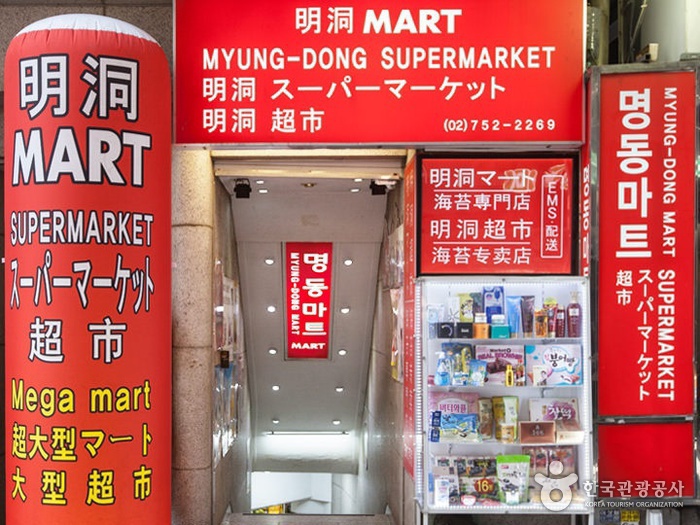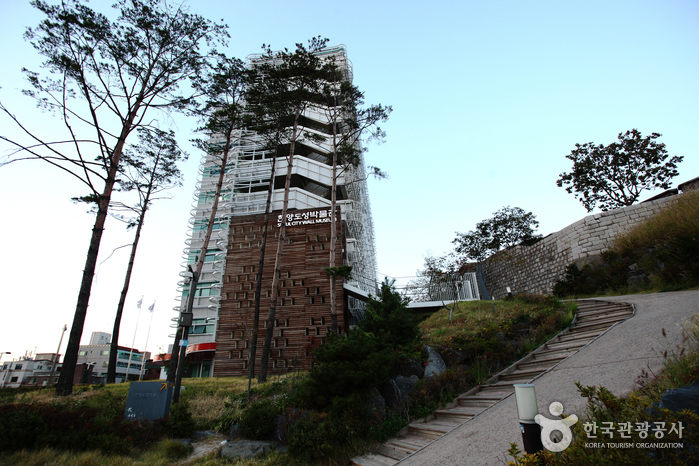Olens - Myeong-dong Embassy Branch [Tax Refund Shop] (오렌즈 명동대사관점)
2.8Km 2024-04-22
50, Myeongdong 2-gil, Jung-gu, Seoul
-
Harmony Mart Myeong-dong Station Branch (하모니마트 명동역점)
2.8Km 2024-12-23
58 , Myeongdong 10-gil, Jung-gu, Seoul
+82-2-752-2269
Harmony Mart Myeongdong Station Branch is a discount supermarket specializing in Korean products popular with foreign tourists. It’s on the 1st basement floor of the Shinil Building annex, just a minute's walk from Exit 8 of Myeongdong Subway Station, Jungu, Seoul. Shop here for kimchi, seaweed, ginseng products, tea, ramen, handicrafts, daily necessities and souvenirs. English, Chinese, and Japanese are spoken, and payments can be made in yen and yuan. With purchases of KRW 50,000 or more, there’s free delivery to accomodations within a 5km radius.
Myeong-dong Mart - Myeong-dong Branch [Tax Refund Shop] (명동마트 명동)
2.8Km 2024-04-18
B1F, 58, Myeongdong 10-gil, Jung-gu, Seoul
-
Bongchu Jjimdak Myeongdong Post Office (봉추찜닭 명동중앙우체국)
2.8Km 2024-03-12
47, Myeongdong, 8na-gil, Jung-gu, Seoul
+82-2-3789-9381
Located in Myeongdong Street, Bongchu Jjimdak Myeongdong Post Office branch specializes in jjimdak (braised chicken). Jjimdak is a Korean-style soy sauce glazed chicken that originated in the Andong region and features chicken stir-fried with potatoes, carrots, onions, garlic, glass noodles, and rice cakes. Their signature dish is ppyeo eomneun jjimdak (braised boneless chicken), which is easy to eat even for beginners. Its spicy level can be adjusted and cheese can be added to suit personal preferences.
Myeongdong Yeongyang Center (명동 영양센터)
2.8Km 2024-03-11
52, Myeongdong 2-gil, Jung-gu, Seoul
+82-2-776-2015
Myeongdong Yeongyang Center specializes in roasted chicken and ginseng chicken soup. The jeongi gui tongdak (rotisserie chicken) is light and juicy with just the right amount of fat, and the crispy skin is excellent. The vinegar-marinated radishes are a must-have side dish. Samgye tang (ginseng chicken soup) is also the signature dish of the restaurant. The lunch special, Tongdak set menu (Roasted chicken set menu), features roasted chicken, chicken soup, nutritional bread, and vegetables, offering a satisfying ensemble.
Myeongdongjeong Royal Cuisine Restaurant (명동정)
2.8Km 2024-03-12
1F, 299, Samil-daero, Jung-gu, Seoul
+82-2-3789-5132
Located on Myeongdong Street, Myeongdongjeong Royal Cuisine Restaurant serves Korean traditional dishes. They offer Korean traditional dishes that were once prepared for Korean royalty and nobility, using premium ingredients such as blue crab, abalone, beef, shrimp, and pumpkin. Their Korean table d'hote menus feature youngran sang (weekday lunch special), myeongdong jeongsik (bulgogi and other traditional dishes), gwibin sang (abalone & beef rib stew with traditional various dishes), and haesin sang (high-quality seafood dishes). With various rooms and halls, the venue also has space for organizing simple parties.
Yetmat Seoul Bulgogi (옛맛서울불고기)
2.8Km 2024-03-20
57, Myeongdong, 2-gil, Jung-gu, Seoul
+82-2-779-3000
Located in Myeongdong, Yetmat Seoul Bulgogi is a Korean restaurant that specializes in Seoul-style bulgogi. It is a thinly sliced, seasoned beef sirloin cooked in a broth with onions, green onions, and mushrooms. The characteristic of this menu is that the bulgogi is mildly flavored and dipped in soybean paste to suit your taste.
Bando Camera - Myeong-dong Chungmu [Tax Refund Shop] (반도카메라 명동충무)
2.8Km 2024-04-17
16, Samil-daero 4-gil, Jung-gu, Seoul
-
Seoul City Wall Museum (한양도성박물관)
2.8Km 2023-12-22
283, Yulgok-ro, Jongno-gu, Seoul
+82-2-724-0243
Hanyangdoseong, the Seoul City Wall, built in 1396, was the city fortress wall that protected the capital city Seoul for over 600 years. The fortress wall was built along the terrains and although it became partially damaged during the modernization process, its original form remains well to this day, making it a cultural heritage that coexists with the modern city. The Seoul City Wall Museum, located in Heungjinjimun Park, is a museum containing the history and culture of city wall from the Joseon dynasty to the present. It is a cultural space with a permanent exhibition hall, special exhibition hall, city wall information center, and study room.
57 Myeongdong Hostel [Korea Quality] / 57명동호스텔 [한국관광 품질인증]
2.8Km 2024-07-30
57 , Myeongdong 2-gil, Jung-gu, Seoul
+82-2-778-8835, +82-10-3262-3503
Located in Myeong-dong, Jung-gu, Seoul, 57 Myeongdong Hostel is easy to remember because its name is the same as its address! Just a 5-minute walk from an airport bus-stop, and a 3-minute walk from Myeongdong metro station, the hostel offers single rooms with ensuite bathrooms, and is popular with single travelers or those on business trips. Breakfast, coffee and tea are provided free, and a mini washing machine can be used without charge. The hostel is close to the Myeongdong shopping district, and is also convenient for nearby tourist attractions. Tourist information and reservation services are provided at the front desk.
![Olens - Myeong-dong Embassy Branch [Tax Refund Shop] (오렌즈 명동대사관점)](http://tong.visitkorea.or.kr/cms/resource/05/2878605_image2_1.jpg)

![Myeong-dong Mart - Myeong-dong Branch [Tax Refund Shop] (명동마트 명동)](http://tong.visitkorea.or.kr/cms/resource/30/2878630_image2_1.jpg)

![Bando Camera - Myeong-dong Chungmu [Tax Refund Shop] (반도카메라 명동충무)](http://tong.visitkorea.or.kr/cms/resource/63/2878663_image2_1.jpg)

![57 Myeongdong Hostel [Korea Quality] / 57명동호스텔 [한국관광 품질인증]](http://tong.visitkorea.or.kr/cms/resource/34/2610934_image2_1.jpg)
 English
English
 한국어
한국어 日本語
日本語 中文(简体)
中文(简体) Deutsch
Deutsch Français
Français Español
Español Русский
Русский